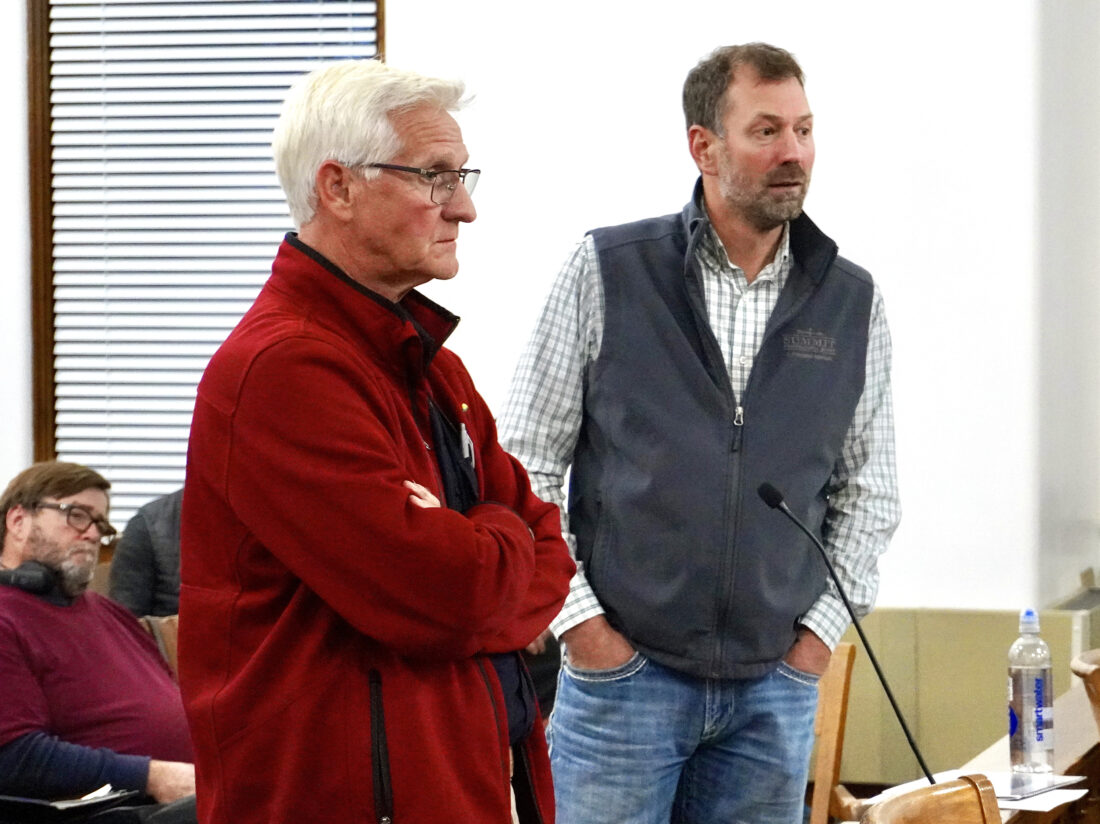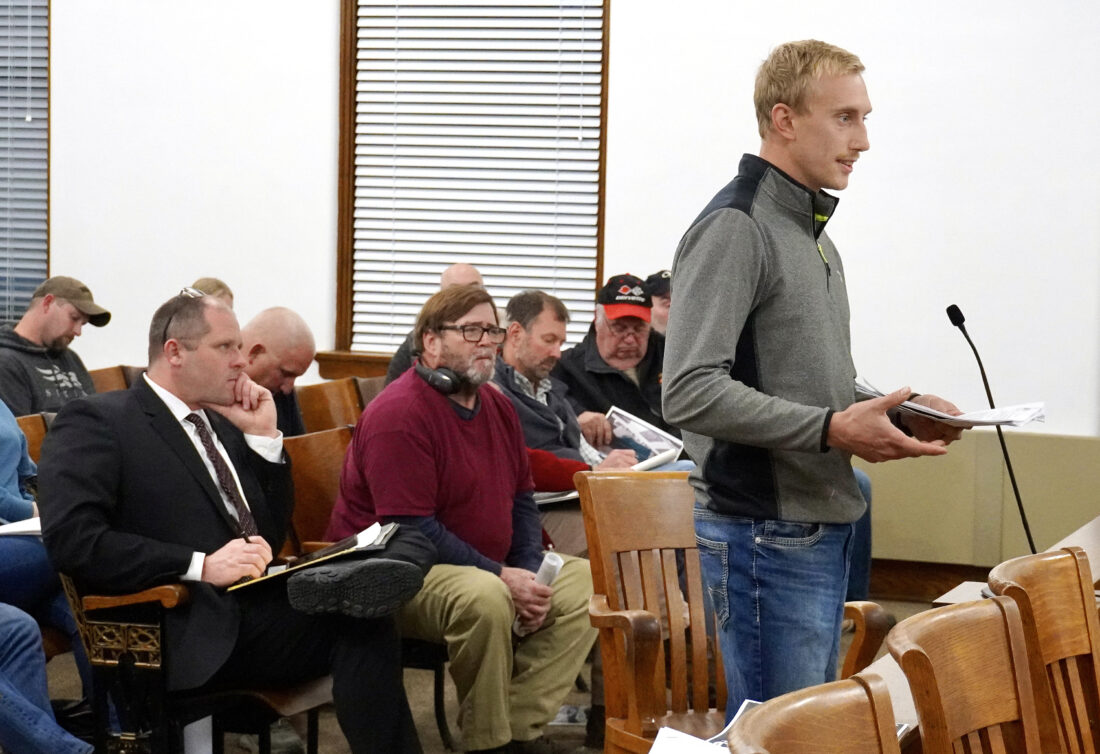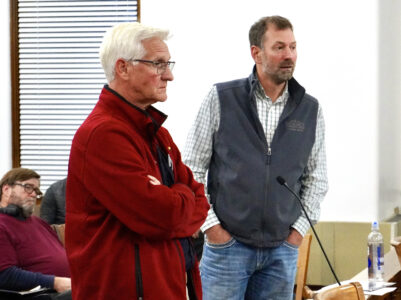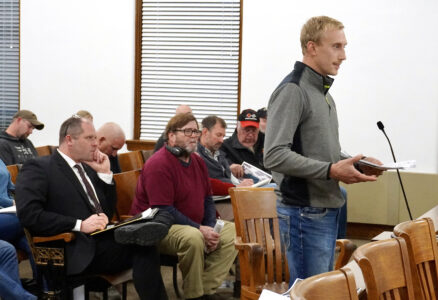Proposed swine operation in Pierce County generates debate

Jill Schramm/MDN Kent Krause, left, president of Pinnacle, which provides environmental services to Dakota SAO, and Mitch Baum, right, representing Dakota SAO, stand before the Pierce County Planning and Zoning Board Thursday, Oct. 16, to talk about plans for a commercial hog operation in the county.
RUGBY – Concerns about a proposed swine operation’s odor and impact on water supplies led to protests against its permit request at the Pierce County Planning and Zoning hearing Thursday, Oct. 16, in Rugby.
The zoning board took no action after about a two-hour hearing but scheduled discussion for Wednesday, Nov. 5, at 6 p.m. A recommendation from the board would go to the Pierce County Commission for a final decision.
Not all residents who attended the public hearing opposed the plan of Dakota SAO II, LLP, which also has a pending permit request before the North Dakota Department of Environmental Quality.
“My concern is doing it right,” said Paul Overby, Wolford, whose farm is about three and a half miles from the proposed facility north of N.D. Highway 17 on the Pierce County side of the Pierce and Towner county line. “The benefits can include employment opportunities for area residents, local use of crops, which are corn or soybeans, and an excellent source of plant nutrients in the form of manure.”
However, he listed potential pitfalls, citing his own concern about manure applied as fertilizer seeping into waterways leading to Hurricane Lake and eventually Devils Lake.

Jill Schramm/MDN Lincoln Larson, right, addresses the Pierce County Planning and Zoning Board Thursday, Oct. 16, in a courtroom nearly filled with residents with opinions on a proposed hog barn operation.
“I support it conditionally,” Overby told the board. “I really think you guys need to work hand in glove with the DEQ, not to be in a hurry to approve this. Rather, take your time with it.”
Dakota SAO currently owns the swine facility east of Cando that was originally developed by the Gibbens family in 2003. The sow farm has nearly 6,094 head, said Mitch Baum, representing Dakota SAO.
The 80-acre parcel between Cando and Wolford being eyed for a second operation was originally permitted for a sow farm in 2007 by the Gibbens family. Those plans fell by the wayside. Dakota SAO has revived the project with a plan that includes more modern and environmentally friendly features and promises 18 jobs.
The facility would have a capacity of 6,510 sows, nearly 2,000 replacement gilts and 792 nursery gilts. Gilts not kept for sow replacement, along with barrows, will be transferred off site to other growers, Baum said. He estimated traffic impact at about six to seven trucks a week traveling to and from the site.
All Seasons Water Users District has been investigating how it might meet the facility’s need for about 35,000-40,000 gallons of water a day, with up to 60,000 gallons at peak summer times. Residents have voiced concern about the draw on the aquifer’s capacity.
Dan Schaefer, manager of the rural water district, said the district is conducting a hydraulic study.
All Seasons receives treated water through the Rugby treatment plant, with distribution rights of up to 360,000 gallons a day. It was noted All Seasons has reached or exceeded that, particularly when farmers are using water to spray fields.
The plant could increase capacity, which would increase employee time and cost, said Rugby City Council member Neil Lotvedt. He also questioned whether the water demand of the hog farm would tie the hands of the city if it wants to bring in a future development with high water needs.
Three residences are within two miles of the proposed facility, which is required to have a one-mile buffer.
Lincoln Larson, the closest resident to the facility, objected to the odor.
“It does cause a lot of air pollution, including ammonia and sulfide, which can cause diverse physiological responses,” he said.
His father, Guy Larson, who farms southeast of the proposed facility, spoke about the impact of the odor on his parents who still live on the farm that had belonged to his grandparents.
“How would you feel if you spent your life building a generational farm only to see a group of primarily out-of-state investors come in and ruin your way of life?” Larson said. “Something should not come in and just decimate an entire family.
Baum said the operation will have below-building, concrete collection pits for manure, with capacity to store up to 16 months of production, or 180% more than the state requires. The manure management program expects to apply manure to about 1,200 acres annually, based on an acreage rotation system.
Jon Nelson, Rugby, a state legislator and Rugby City Council member, listed a declining local population and uncertain grain prices as reasons to consider the hog operation.
“If we don’t do anything ourselves to create a better environment and use our own products for our own use, I think that’s the bigger danger of our communities drying up,” he said. “We need to work very diligently to accept proposals like this because it’s good for North Dakota.”
With permit approvals, Baum said, the swine facility construction should be complete and animal stocking started in late 2026 or early 2027.
- Jill Schramm/MDN Kent Krause, left, president of Pinnacle, which provides environmental services to Dakota SAO, and Mitch Baum, right, representing Dakota SAO, stand before the Pierce County Planning and Zoning Board Thursday, Oct. 16, to talk about plans for a commercial hog operation in the county.
- Jill Schramm/MDN Lincoln Larson, right, addresses the Pierce County Planning and Zoning Board Thursday, Oct. 16, in a courtroom nearly filled with residents with opinions on a proposed hog barn operation.





